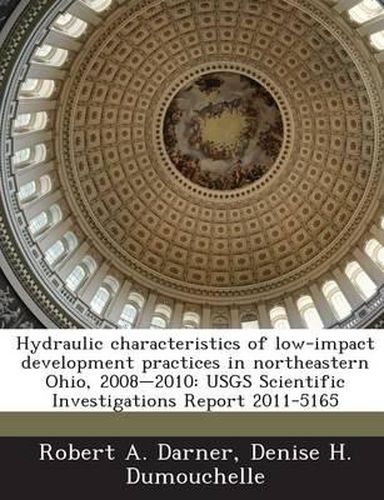Readings Newsletter
Become a Readings Member to make your shopping experience even easier.
Sign in or sign up for free!
You’re not far away from qualifying for FREE standard shipping within Australia
You’ve qualified for FREE standard shipping within Australia
The cart is loading…






Low-impact development (LID) is an approach to managing stormwater as near to its source as possible; this is accomplished by minimizing impervious surfaces and promoting more natural infiltration and evapotranspiration than is typically associated with developed areas. Two newly constructed LID sites in northeastern Ohio were studied to document their hydraulic characteristics. A roadside best-management practice (BMP) was constructed by replacing about 1,400 linear feet of existing ditches with a bioswale/rain garden BMP consisting of a grassed swale interspersed with rain-garden/overflow structures. The site was monitored in 2008, 2009, and 2010. Although some overflows occurred, numerous precipitation events exceeding the 0.75-inch design storm did not result in overflows. A second study site consists of an 8,200-square-foot parking lot made of a pervious pavers and a rain garden that receives runoff from the roof of a nearby commercial building. A comparison of data from 2009 and 2010 indicates that the median runoff volume in 2010 decreased relative to 2009. The centroid lag times (time difference between centroid of precipitation and centroid of flow) decreased in 2010, most likely due to more intense, shorter duration precipitation events and maturation of the rain garden. Additional data could help quantify the relation between meteorological variables and BMP efficiency.
$9.00 standard shipping within Australia
FREE standard shipping within Australia for orders over $100.00
Express & International shipping calculated at checkout
Low-impact development (LID) is an approach to managing stormwater as near to its source as possible; this is accomplished by minimizing impervious surfaces and promoting more natural infiltration and evapotranspiration than is typically associated with developed areas. Two newly constructed LID sites in northeastern Ohio were studied to document their hydraulic characteristics. A roadside best-management practice (BMP) was constructed by replacing about 1,400 linear feet of existing ditches with a bioswale/rain garden BMP consisting of a grassed swale interspersed with rain-garden/overflow structures. The site was monitored in 2008, 2009, and 2010. Although some overflows occurred, numerous precipitation events exceeding the 0.75-inch design storm did not result in overflows. A second study site consists of an 8,200-square-foot parking lot made of a pervious pavers and a rain garden that receives runoff from the roof of a nearby commercial building. A comparison of data from 2009 and 2010 indicates that the median runoff volume in 2010 decreased relative to 2009. The centroid lag times (time difference between centroid of precipitation and centroid of flow) decreased in 2010, most likely due to more intense, shorter duration precipitation events and maturation of the rain garden. Additional data could help quantify the relation between meteorological variables and BMP efficiency.